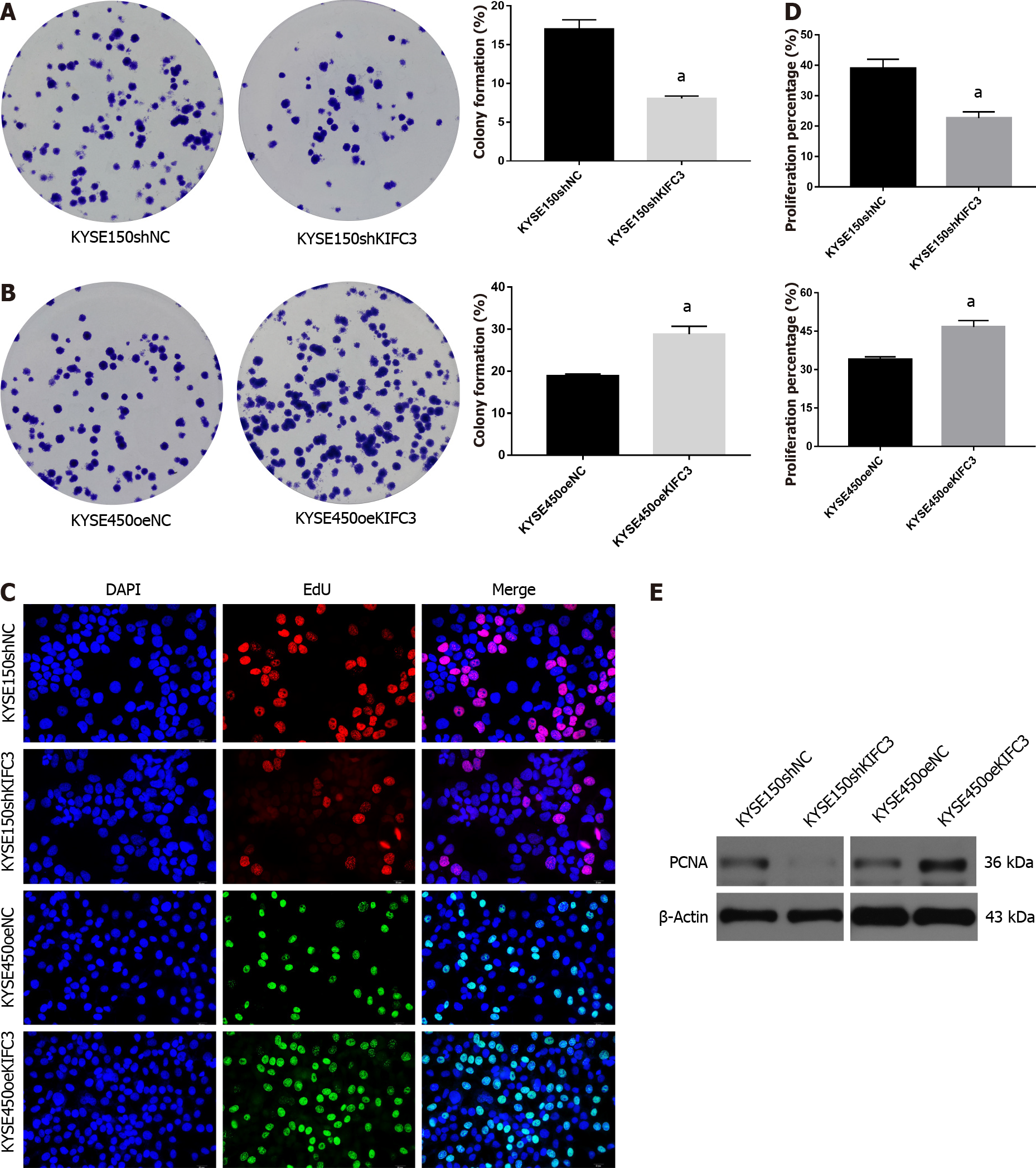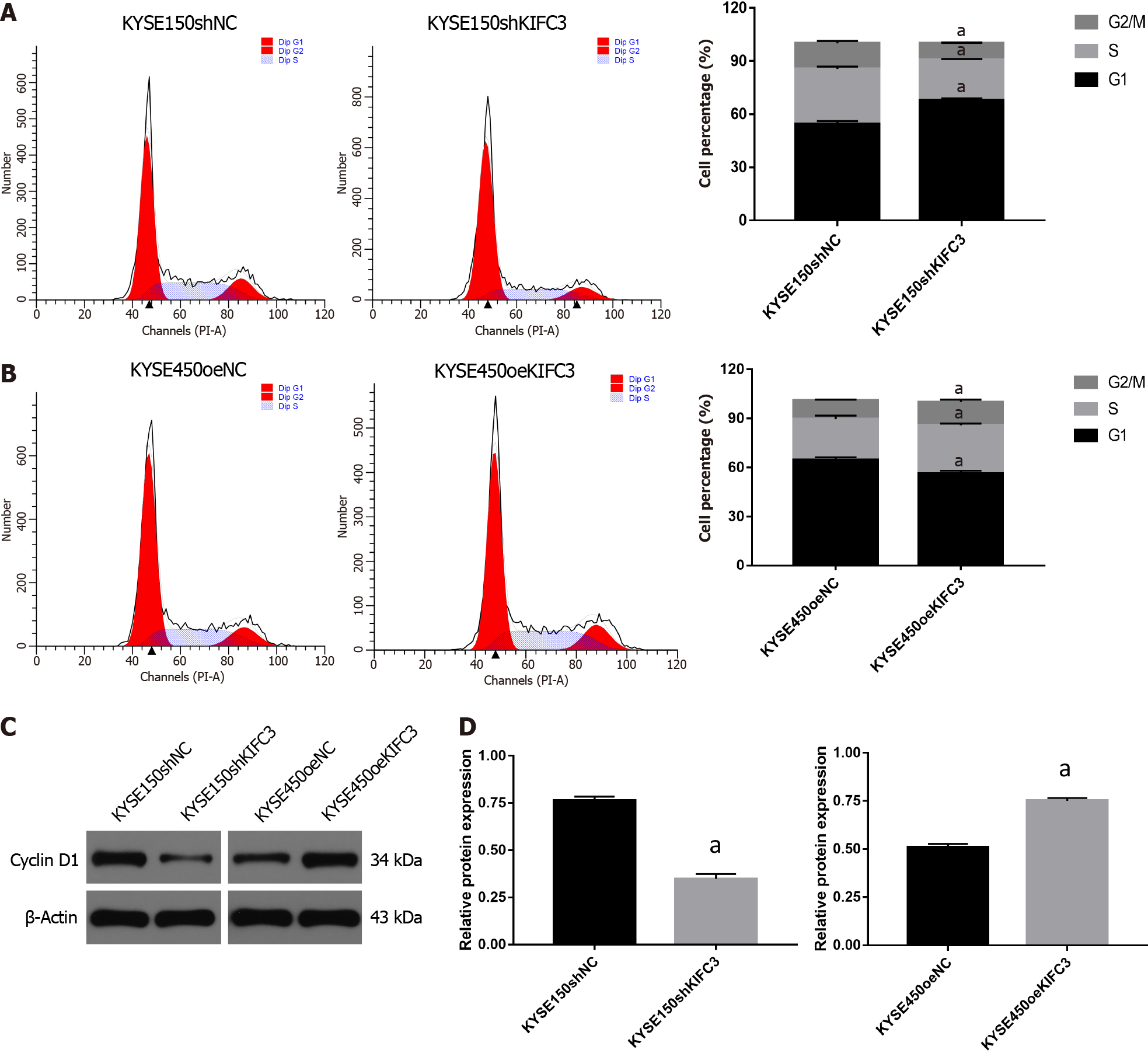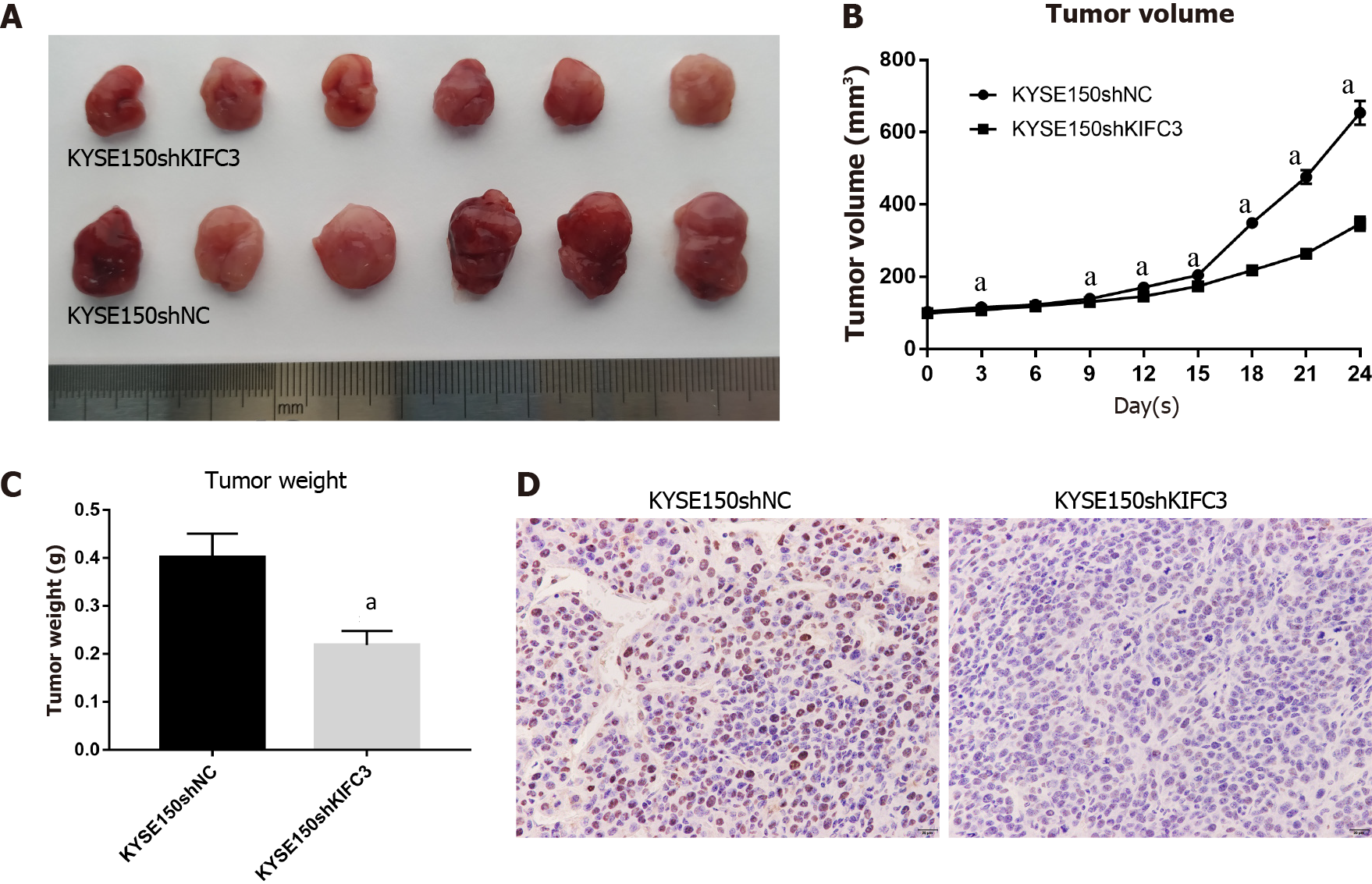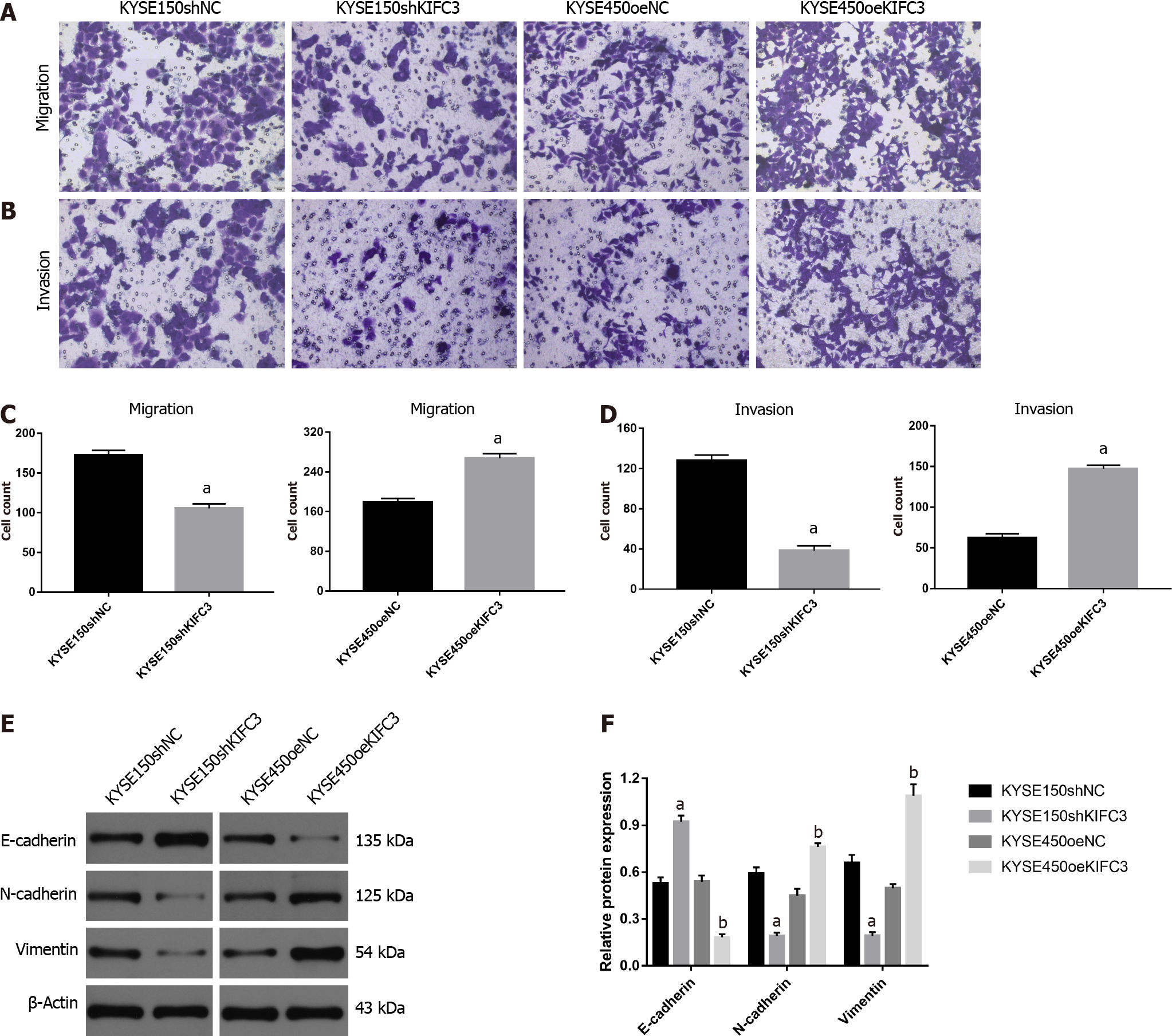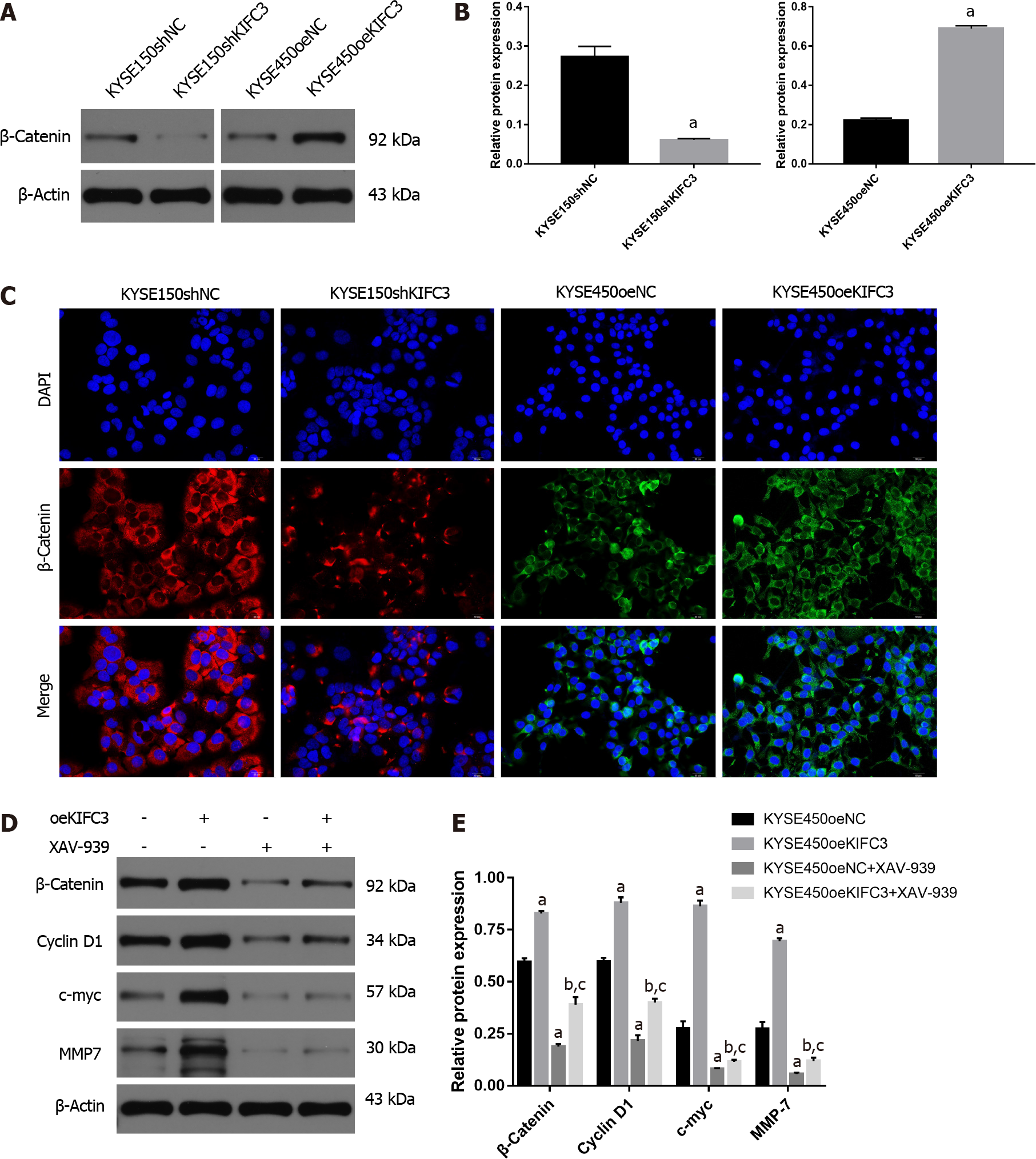Copyright
©The Author(s) 2022.
World J Gastrointest Oncol. Jul 15, 2022; 14(7): 1239-1251
Published online Jul 15, 2022. doi: 10.4251/wjgo.v14.i7.1239
Published online Jul 15, 2022. doi: 10.4251/wjgo.v14.i7.1239
Figure 1 KIFC3 is overexpressed in ESCC tissues and is associated with poor prognosis.
A: Immunohistochemistry shows that KIFC3 is overexpressed in ESCC tissues compared with adjacent normal tissues, scale bar: 500 μm; B: Kaplan–Meier Plotter shows that high levels of KIFC3 are associated with poor prognosis in ESCC patients; C: Western blotting shows expression of KIFC3 in ESCC cell lines and normal esophageal epithelial cell line Het-1A; D: Western blotting shows that KIFC3-knockdown and KIFC3-overexpressed cell lines are constructed successfully. ESCC: Esophageal squamous cell carcinoma; KIFC3: Kinesin family member C3.
Figure 2 KIFC3 promotes proliferation in human ESCC cells.
A: Colony-formation assay shows that KIFC3 knockdown inhibits colony formation in KYSE150 cells; B: Colony-formation assay shows that KIFC3 overexpression promotes colony formation in KYSE450 cells; C: EdU proliferation assay shows that KIFC3 knockdown inhibits proliferation in KYSE150 cells, while its overexpression promotes proliferation in KYSE450 cells, scale bar: 20 μm; D: Statistical analysis of the data shown in C; E: Western blotting shows that KIFC3 promotes the expression of proliferating cell nuclear antigen in ESCC cells. aP < 0.05 versus the control group. ESCC: Esophageal squamous cell carcinoma; KIFC3: Kinesin family member C3.
Figure 3 KIFC3 promotes the progression of cell cycle in ESCC cells.
A: Cell cycle analysis showing that KIFC3 knockdown induces cell cycle arrest in KYSE150 cells; B: Cell cycle analysis showing that KIFC3 overexpression promotes the progression of cell cycle in KYSE450 cells; C: Western blotting showing that KIFC3 knockdown decreases the expression of cyclin D1 in KYSE150 cells, while KIFC3 overexpression increased the expression of cyclin D1 in KYSE450 cells; D: Statistical analysis of the data presented in C. aP < 0.05 versus the control group. ESCC: Esophageal squamous cell carcinoma; KIFC3: Kinesin family member C3.
Figure 4 KIFC3 knockdown inhibits the growth of ESCC cells in vivo.
A: Images of tumors formed in nude mice; B: Volume curves of xenograft tumors; C: Weight of xenograft tumors; D: Immunohistochemistry showing that KIFC3 knockdown inhibits the expression of Ki-67, scale bar: 20 μm. aP < 0.05 versus the control group. ESCC: Esophageal squamous cell carcinoma; KIFC3: Kinesin family member C3.
Figure 5 KIFC3 promotes migration, invasion, and EMT in human ESCC cells.
A: Transwell migration assay showing that KIFC3 knockdown inhibits migration in KYSE150 cells, while its overexpression promotes migration in KYSE450 cells, scale bar: 20 μm; B: Transwell invasion assay showing that KIFC3 knockdown inhibits invasion in KYSE150 cells, while its overexpression promotes invasion in KYSE450 cells, scale bar: 20 μm; C: Statistical analysis of cell migration; D: Statistical analysis of cell invasion; E: Western blotting showing that KIFC3 knockdown inhibits epithelial-mesenchymal transition (EMT), while KIFC3 overexpression promotes EMT in ESCC cells; F: Statistical analysis of E. aP < 0.05 vs the KYSE150shNC group, bP < 0.05 vs the KYSE450oeNC group. ESCC: Esophageal squamous cell carcinoma; EMT: Epithelial–mesenchymal transition; KIFC3: Kinesin family member C3.
Figure 6 KIFC3 promotes the progression of ESCC via β-catenin signaling.
A: Western blotting showing that KIFC3 knockdown inhibits, while its overexpresssion promotes the expression of β-catenin in ESCC cells; B: Statistical analysis of the data presented in A; C: Immunofluorescence showing that KIFC3 knockdown inhibits, while its overexpression promotes the expression of β-catenin, scale bar: 20 μm; D: Inhibitor of β-catenin, XAV-939 is used to treat KYSE450oeNC and KYSE450oeKIFC3 cells, then western blotting is used to detect downstream molecules of β-catenin signaling; E: Statistical analysis of the data presented in D. aP < 0.05 vs the KYSE450oeNC group, bP < 0.05 versus the KYSE450oeNC+ XAV-939 group, cP < 0.05 vs the KYSE450oeKIFC3 group. ESCC: Esophageal squamous cell carcinoma; KIFC3: Kinesin family member C3.
- Citation: Hao WW, Xu F. KIFC3 promotes proliferation, migration and invasion of esophageal squamous cell carcinoma cells by activating EMT and β-catenin signaling. World J Gastrointest Oncol 2022; 14(7): 1239-1251
- URL: https://www.wjgnet.com/1948-5204/full/v14/i7/1239.htm
- DOI: https://dx.doi.org/10.4251/wjgo.v14.i7.1239














